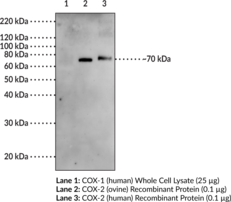Description
Histone H4 is one of four core histone proteins that are involved in the organization of DNA into chromatin.{18136} Histones are globular proteins with unstructured N-terminal tails and are subject to a variety of post-translational modifications, such as methylation, acetylation, phosphorylation, and citrullination, that can influence chromatin structure and regulate gene transcription.{18136,57056} Phosphorylation of histone H4 at serine 1 (H4S1Ph) is increased during the S-phase and mitosis in HeLa cells, C. elegans, and Drosophila, as well as during spermatogenesis in mice.{54369,54370} MG-63 cells expressing a serine-to-alanine substitution at Ser1 in histone H4, which abolishes its phosphorylation, have reduced markers of autophagy. Cayman’s Histone H4S1Ph Monoclonal Antibody can be used for ELISA, immunocytochemistry (ICC), multiplex-based assays, and Western blot (WB) applications.
Synonyms: H4pS1|H4pSer1|Histone H4 (Phospho-Ser1)|Phospho-Histone H4 Serine 10|Phosphorylated Histone H4 Serine 1
Immunogen: Peptide corresponding to H4S1Ph
Formulation: 100 µg of protein A-affinity purified monoclonal antibody
Isotype: IgG
Applications: ELISA, ICC, multiplex-based assays, WB
Origin:
Stability: 365 days
Application|ELISA||Application|Immunocytochemistry||Application|Multiplex||Application|Western Blot||Product Type|Antibodies|Monoclonal Antibodies||Research Area|Cell Biology|Cell Cycle||Research Area|Cell Biology|Endomembrane System & Vesicular Trafficking|Autophagy||Research Area|Endocrinology & Metabolism|Reproductive Biology||Research Area|Epigenetics, Transcription, & Translation|Histones/Histone Peptides|Phosphorylated||Research Area|Epigenetics, Transcription, & Translation|Writers|Phosphorylation



